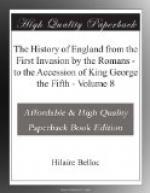[Footnote 1: They were lord Talbot, son to the earl of Shrewsbury, “with about sixty horse; Mr. Mervin Touchet, Sir John Packington, Sir Walter Blount, Sir Ralph Clare, Mr. Ralph Sheldon, of Beoly, Mr. John Washbourn, of Wichinford, with forty horse; Mr. Thomas Hornyhold, of Blackmore-park, with forty horse; Mr. Thomas Acton, Mr. Robert Blount, of Kenswick, Mr. Robert Wigmore, of Lucton, Mr. F. Knotsford, Mr. Peter Blount, and divers others.”—Boscobel, 10.]
[Footnote 2: Cary’s Memorials, ii. 361.]
[Sidenote a: A.D. 1651. August 23.] [Sidenote b: A.D. 1651. August 26.] [Sidenote c: A.D. 1651. August 28.]
auspicious day, the 3rd of September, on which twelve months before he had defeated the Scots at Dunbar. On that morning Fleetwood, who had advanced from Upton to Powick,[a] was ordered to force the passage of the Team, while Cromwell, to preserve the communication, should throw a bridge of boats across the Severn at Bunshill, near the confluence of the two rivers. About one in the afternoon, while Charles with his staff observed from the tower of the cathedral the positions of the enemy, his attention was drawn by a discharge of musketry near Powick. He descended immediately, rode to the scene of action, and ordered Montgomery with a brigade of horse and foot to defend the line of the Team and oppose the formation of the bridge. After a long and sanguinary struggle, Fleetwood effected a passage just at the moment when Cromwell, having completed the work, moved four regiments to his assistance. The Scots, though urged by superior numbers, maintained the most obstinate resistance; they disputed every field and hedge, repeatedly charged with the pike to check the advance of the enemy, and, animated by the shouts of the combatants on the opposite bank, sought to protract the contest with the vain hope that, by occupying the forces of Fleetwood, they might insure the victory to their friends, who were engaged with Cromwell.
That commander, as soon as he had secured the communication across the river, ordered a battery of heavy guns to play upon Fort Royal, a work lately raised to cover the Sidbury gate of the city, and led his troops in two divisions to Perrywood and Red-hill. To Charles this seemed a favourable opportunity of defeating one half of the hostile force, while the other
[Sidenote a: A.D. 1651. Sept. 3.]
half was separated from it by the Severn. Leading out the whole of his disposable infantry, with the duke of Hamilton’s troop of horse, and the English volunteers, he marched to attack the enemy in their position, and fought at the head of the Highlanders with a spirit worthy of a prince who staked his life for the acquisition of a crown. Fortune favoured his first efforts. The militia regiments shrunk from the shock, and the guns of the enemy became the prize of the assailants. But Cromwell had placed some veteran battalions in reserve. They restored




